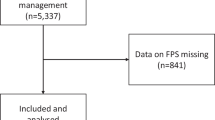Abstract
Objective
Assess the risk of complications during endotracheal intubation (ETI) and their association with the skill level of the intubating physician.
Design
Prospective cohort study of 136 patients intubated by the intensive care team during a 5-month period. Standardized data forms were used to collect detailed information on the intubating physicians, supervisors, techniques, medications and complications.
Setting
Canadian academic intensive care unit.
Measurements and results
All intubations were successful and there were no deaths during intubation. Non-experts were supervised in 92% of procedures. Expert operators were successful within two attempts in 94%, compared to only 82% of non-experts (P = 0.03), with 13.2% of all intubations requiring ≥3 attempts. Furthermore, 10.3% of intubations required 10 or more minutes. Difficult intubation (3 or more attempts by an expert) occurred in 6.6%. Overall risk of complications was 39%, including: severe hypoxemia (19.1%), severe hypotension (9.6%), esophageal intubation (7.4%) and frank aspiration (5.9%). ICU and hospital mortality were 15.4 and 29.4%, respectively. Compared with non-expert intubating physicians, propensity score-adjusted odds ratios (95% confidence interval) for expert physicians were 0.92 (95% CI: 0.28, 3.05, P = 0.89) for any complication, 0.45 (95% CI: 0.09, 2.20, P = 0.32) for ICU mortality and 0.47 (95% CI: 0.13, 1.70, P = 0.25) for hospital mortality. Two or more attempts at ETI was independently associated with an increased risk of severe complications (OR 3.31, 95% CI: 1.30, 8.40, P = 0.01).
Conclusions
These prospective data show a high risk of serious complications, and difficult intubations, that are associated with ETI of the critically ill.
Descriptor
Artificial airways and complications.
Similar content being viewed by others
References
Cheney FW, Posner KL, Lee LA, Caplan RA, Domino KB (2006) Trends in anesthesia-related death and brain damage: a closed claims analysis. Anesthesiology 105:1081–1086
Matioc AA, Arndt G (2005) The critical airway. Can J Anesth 52:993–995
Walz JM, Zayaruzny M, Heard SO (2007) Airway management in critical illness. Chest 131:608–620
Schwartz DE, Matthay MA, Cohen NH (1995) Death and other complications of emergency airway management in critically ill adults. A prospective investigation of 297 tracheal intubations. Anesthesiology 82:367–376
Le Tacon S, Wolter P, Rusterholtz T, Harlay M, Gayol S, Sauder P, Jaeger A (2000) Complications des intubations tracheales difficiles dans un service de reanimation medicale [complications of difficult tracheal intubations in a critical care unit]. Ann Fr Anesth Reanim 19:719–724
Reid C, Chan L, Tweeddale M (2004) The who, where, and what of rapid sequence intubation: prospective observational study of emergency RSI outside the operating theatre. Emerg Med J 21:296–301
Jaber S, Amraoui J, Lefrant JY, Arich C, Cohendy R, Landreau L, Calvet Y, Capdevila X, Mahamat A, Eledjam JJ (2006) Clinical practice and risk factors for immediate complications of endotracheal intubation in the intensive care unit: a prospective, multiple-center study. Crit Care Med 34:2355–2361
Cormack RS, Lehane J (1984) Difficult tracheal intubation in obstetrics. Anaesthesia 39:1105–1111
Practice guidelines for management of the difficult airway (1993) A report by the American Society of Anesthesiologists Task Force on Management of the difficult airway. Anesthesiology 78:597–602
Pepe PE, Roppolo LP, Fowler RL (2005) The detrimental effects of ventilation during low-blood-flow states. Curr Opin Crit Care 11:212–218
Benedetto WJ, Hess DR, Gettings E, Bigatello LM, Toon H, Hurford WE, Schmidt U (2007) Urgent tracheal intubation in general hospital units: an observational study. J Clin Anesth 19:20–24
Sakles JC, Laurin EG, Rantapaa AA, Panacek EA (1998) Airway management in the emergency department: a one-year study of 610 tracheal intubations. Ann Emerg Med 31:325–332
Mort TC (2004) Emergency tracheal intubation: complications associated with repeated laryngoscopic attempts. Anesth Analg 99:607–613
Crosby ET, Cooper RM, Douglas MJ, Doyle DJ, Hung OR, Labrecque P, Muir H, Murphy MF, Preston RP, Rose DK, Roy L (1998) The unanticipated difficult airway with recommendations for management. Can J Anaesth 45:757–776
Mort TC (2005) Preoxygenation in critically ill patients requiring emergency tracheal intubation. Crit Care Med 33:2672–2675
Duke GJ (1999) Cardiovascular effects of mechanical ventilation. Crit Care Resusc 1:388–399
Baillard C, Fosse JP, Sebbane M, Chanques G, Vincent F, Courouble P, Cohen Y, Eledjam JJ, Adnet F, Jaber S (2006) Noninvasive ventilation improves preoxygenation before intubation of hypoxic patients. Am J Respir Crit Care Med 174:171–177
Kory PD, Eisen LA, Adachi M, Ribaudo VA, Rosenthal ME, Mayo PH (2007) Initial airway management skills of senior residents: simulation training compared with traditional training. Chest 132:1927–1931
Mayo PH, Hackney JE, Mueck JT, Ribaudo V, Schneider RF (2004) Achieving house staff competence in emergency airway management: results of a teaching program using a computerized patient simulator. Crit Care Med 32:2422–2427
Peduzzi P, Concato J, Kemper E, Holford TR, Feinstein AR (1996) A simulation study of the number of events per variable in logistic regression analysis. J Clin Epidemiol 49:1373–1379
Cepeda MS, Boston R, Farrar JT, Strom BL (2003) Comparison of logistic regression versus propensity score when the number of events is low and there are multiple confounders. Am J Epidemiol 158:280–287
Acknowledgments
We gratefully acknowledge Ms. Shelly Fleck-McCaskill for her invaluable assistance with data acquisition. We also thank the Respiratory Therapists and Nurses at Vancouver General Hospital for their support of this project.
Author information
Authors and Affiliations
Corresponding author
Rights and permissions
About this article
Cite this article
Griesdale, D.E.G., Bosma, T.L., Kurth, T. et al. Complications of endotracheal intubation in the critically ill. Intensive Care Med 34, 1835–1842 (2008). https://doi.org/10.1007/s00134-008-1205-6
Received:
Accepted:
Published:
Issue Date:
DOI: https://doi.org/10.1007/s00134-008-1205-6



